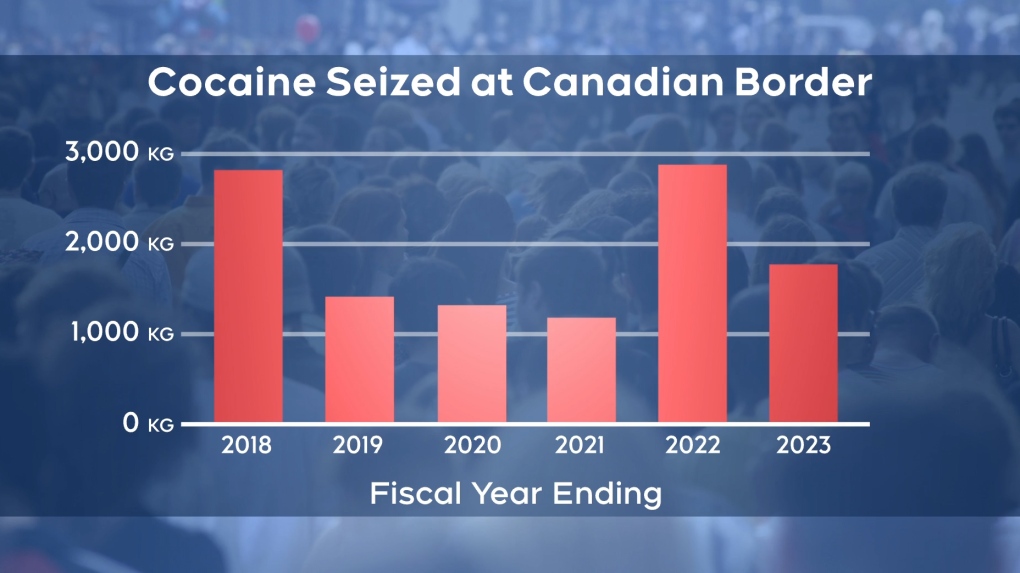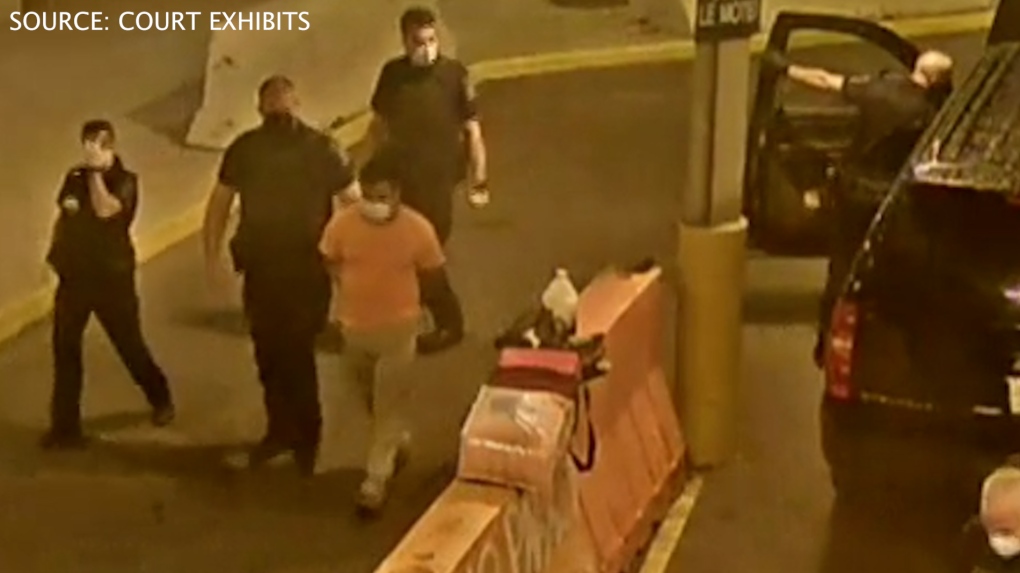Cocaine seizures at Canada's borders spike as pandemic wanes
Cocaine seizures at Canada’s borders rose sharply when restrictions loosened, according to new figures released by the Canadian Border Services Agency, with experts saying it’s a sign that drug traffickers are getting back to business as the pandemic wanes.
Facing a downturn in regular trade, drug trafficking networks turned to couriers which were more likely to be caught at ports of entry, Mount Royal University’s Kelly Sundberg told CTV News Toronto in an interview.
“It was much more difficult for drug dealers to smuggle during [the pandemic],” Sundberg said. “They changed their operation to couriers. It makes sense we’re seeing more seizures at airports and cargo with couriers.”
In the fiscal year ending in 2018, CBSA agents seized 2,860 kg of cocaine, including coca leaves, coca paste, crack cocaine, and cocaine residue, according to figures provided by the agency.
By the fiscal year ending in 2021 — the year that corresponded to the onset of the pandemic — that had nosedived to 1,214 kg of cocaine.
 Source: CBSA
Source: CBSA
The next year, propelled in part by one 1.5-ton seizure in the port of St. John, CBSA cocaine seizures rose to 2,875 kg.
And the following year stayed high, at 1,812 kg — about 50 per cent more than pandemic lows.
A Windsor, Ont. judge weighed in on a CBSA seizure in a decision released this month, finding Federico Jimenez-Martinez guilty of possession for the 18 bricks of cocaine found in his vehicle’s spare tire, worth as much as $2 million.
He admitted having the cocaine in August 2021, but said he had only intended to drive from Arizona to Michigan, U.S., and went over the Ambassador Bridge into Ontario by accident, court documents show.
Prosecutors admitted they couldn’t prove he intended to cross the border, and withdrew an additional trafficking charge.
Jimenez-Martinez claimed that he was under duress, facing threats by cartel members in Mexico if he didn’t deliver.
Justice K.W. Munroe found his brother did receive threats — but it was much more likely that was the cartel looking to enforce a drug debt created when those bricks didn’t arrive at their destination.
 A still image from CBSA surveillance video obtained from Ontario Superior Court shows Federico Jimenez-Martinez being led away as his vehicle is searched by border guards.
A still image from CBSA surveillance video obtained from Ontario Superior Court shows Federico Jimenez-Martinez being led away as his vehicle is searched by border guards.
As seized amounts rise, it’s likely that the amount of cocaine being smuggled in undetected is also increasing, Sundberg said, pointing to figures that show Canadians’ per capita use of cocaine is quite high, and the country has negligible cocaine production.
“Last year, New Zealand seized more cocaine than Canada. A tiny little island in the Pacific. So 3,000 kg sounds like a lot, but it’s to me an indicator that we really need to do a lot more with respect to border security, and we’re not,” he said.
CTVNews.ca Top Stories

Trump threatens to try to take back the Panama Canal. Panama's president balks at the suggestion
Donald Trump suggested Sunday that his new administration could try to regain control of the Panama Canal that the United States “foolishly” ceded to its Central American ally, contending that shippers are charged “ridiculous” fees to pass through the vital transportation channel linking the Atlantic and Pacific Oceans.
Man handed 5th distracted driving charge for using cell phone on Hwy. 417 in Ottawa
An Ottawa driver was charged for using a cell phone behind the wheel on Sunday, the fifth time he has faced distracted driving charges.
Wrongfully convicted N.B. man has mixed feelings since exoneration
Robert Mailman, 76, was exonerated on Jan. 4 of a 1983 murder for which he and his friend Walter Gillespie served lengthy prison terms.
Can the Governor General do what Pierre Poilievre is asking? This expert says no
A historically difficult week for Prime Minister Justin Trudeau and his Liberal government ended with a renewed push from Conservative Leader Pierre Poilievre to topple this government – this time in the form a letter to the Governor General.
opinion Christmas movies for people who don't like Christmas movies
The holidays can bring up a whole gamut of emotions, not just love and goodwill. So CTV film critic Richard Crouse offers up a list of Christmas movies for people who might not enjoy traditional Christmas movies.
More than 7,000 Jeep SUVs recalled in Canada over camera display concern
A software issue potentially affecting the rearview camera display in select Jeep Wagoneer and Grand Cherokee models has prompted a recall of more than 7,000 vehicles.
'I'm still thinking pinch me': lost puppy reunited with family after five years
After almost five years of searching and never giving up hope, the Tuffin family received the best Christmas gift they could have hoped for: being reunited with their long-lost puppy.
10 hospitalized after carbon monoxide poisoning in Ottawa's east end
The Ottawa Police Service says ten people were taken to hospital, with one of them in life-threatening condition, after being exposed to carbon monoxide in the neighbourhood of Vanier on Sunday morning.
New York City police apprehend suspect in the death of a woman found on fire in a subway car
New York City police announced Sunday they have in custody a “person of interest” in the early morning death of a woman who they believe may have fallen asleep on a stationary subway train before being intentionally lit on fire by a man she didn't know.


































